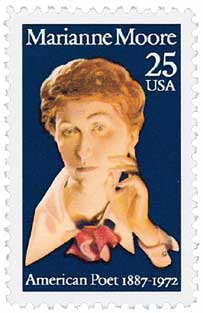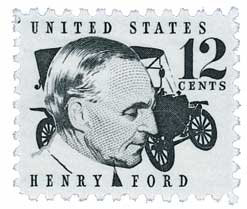
# 4659 - 2012 First-Class Forever Stamp - 20th Century American Poets: Elizabeth Bishop
20th Century American Poet
Issue Date: April 21, 2012
City: Los Angeles, CA
Quantity: 2,000,000
Printed By: Ashton Potter
Printing Method: Offset
Perforations: Die cut 10 ¾ x 11
Color: multicolored
Marianne Craig Moore was born on November 15, 1887, in Kirkwood, Missouri. Considered one of the greatest American female poets, Moore received several distinguished literary awards during her lifetime. Moore grew up around St. Louis until she was 16, after which her family moved to Pennsylvania. Moore attended Bryn Mawr College, where she majored in history, economics, and political science. During her time there, Moore wrote short stories and poems for the school’s literary magazine. It was also during her time at Bryn Mawr that Moore became involved in the women’s suffrage movement. She attended parades and later wrote prose and poetry on the subject. After graduating, Moore worked at the Lake Placid Club and taught business at the Carlisle Indian Industrial School. Moore then decided to commit to writing full time. Her first professionally published poems appeared in The Egoist and Poetry in 1915. The editor of Poetry described her work as containing “an elliptically musical profundity.” Moore moved to Chatham, New Jersey in 1916 and New York City’s Greenwich Village in 1918. There she befriended several avant-garde artists and received high praise from poets such as Ezra Pound, William Carlos Williams, H.D., T.S. Elliot, and Wallace Stevens. Moore’s first book, Poems, was published in 1921 without her permission. Her second book, Observations, was published in 1924 and won the Dial Award. In addition to writing poetry, Moore also worked part-time as a librarian and edited The Dial literary journal. In that role she supported and encouraged many young writers and published their works. Among these were Elizabeth Bishop, Allen Ginsberg, John Ashbery, and James Merrill. In her spare time, Moore also translated the Fables of LaFontaine. Moore earned Poetry magazine’s Helen Haire Levenson Prize in 1933. She lived in seclusion for many years. Then in 1951, her Collected Poems won the National Book Award, the Pulitzer Prize, and the Bollingen Prize. After that success, Moore earned national acclaim, and began speaking at colleges and appearing in magazines such as Life and Look. She also joined the American Academy of Arts and Letters and the American Academy of Arts and Sciences. Her poems were published in The Nation, The New York Republic, Partisan Review, and The New Yorker. In 1955, Moore was approached for an unusual project. Ford Motor Company asked her to suggest names for their new E-car, stating, “Who better to understand the nature of words than a poet?” Moore came up with several imaginative names, including Resilient Bullet, Ford Silver Sword, Mongoose Civique, Varsity Stroke, Pastelogram, Andante con Moto, and Utopian Turtletop. However, in the end they settled on Edsel, named after Henry Ford’s son. In the 1960s, Moore wrote the liner notes for Muhammad Ali’s spoken word album, I am the Greatest! She also threw out the first ball at the Yankee’s season opener in 1968. Moore often used things in nature, such as birds and exotic animals, as the subjects in her poems. They were used as symbols of honesty and steadfastness. She also used her poetry to encourage writers to “create imaginary gardens with real toads in them.” Moore wrote in a clear, precise style that influenced later generations. She is often considered one of the greatest female poets in American history and has been called the “first lady of poetry.” Throughout the course of her career, Moore received several honorary degrees as well as almost every award available to an American poet. She had a series of strokes in her later years and died on February 5, 1972. Moore’s living room was preserved by the Rosenbach Museum and Library in Philadelphia. It includes her entire library, collectibles (including a baseball signed by Mickey Mantle), letters, photos, and poem drafts, all on display for public viewing.Birth of Marianne Moore





20th Century American Poet
Issue Date: April 21, 2012
City: Los Angeles, CA
Quantity: 2,000,000
Printed By: Ashton Potter
Printing Method: Offset
Perforations: Die cut 10 ¾ x 11
Color: multicolored
Marianne Craig Moore was born on November 15, 1887, in Kirkwood, Missouri. Considered one of the greatest American female poets, Moore received several distinguished literary awards during her lifetime. Moore grew up around St. Louis until she was 16, after which her family moved to Pennsylvania. Moore attended Bryn Mawr College, where she majored in history, economics, and political science. During her time there, Moore wrote short stories and poems for the school’s literary magazine. It was also during her time at Bryn Mawr that Moore became involved in the women’s suffrage movement. She attended parades and later wrote prose and poetry on the subject. After graduating, Moore worked at the Lake Placid Club and taught business at the Carlisle Indian Industrial School. Moore then decided to commit to writing full time. Her first professionally published poems appeared in The Egoist and Poetry in 1915. The editor of Poetry described her work as containing “an elliptically musical profundity.” Moore moved to Chatham, New Jersey in 1916 and New York City’s Greenwich Village in 1918. There she befriended several avant-garde artists and received high praise from poets such as Ezra Pound, William Carlos Williams, H.D., T.S. Elliot, and Wallace Stevens. Moore’s first book, Poems, was published in 1921 without her permission. Her second book, Observations, was published in 1924 and won the Dial Award. In addition to writing poetry, Moore also worked part-time as a librarian and edited The Dial literary journal. In that role she supported and encouraged many young writers and published their works. Among these were Elizabeth Bishop, Allen Ginsberg, John Ashbery, and James Merrill. In her spare time, Moore also translated the Fables of LaFontaine. Moore earned Poetry magazine’s Helen Haire Levenson Prize in 1933. She lived in seclusion for many years. Then in 1951, her Collected Poems won the National Book Award, the Pulitzer Prize, and the Bollingen Prize. After that success, Moore earned national acclaim, and began speaking at colleges and appearing in magazines such as Life and Look. She also joined the American Academy of Arts and Letters and the American Academy of Arts and Sciences. Her poems were published in The Nation, The New York Republic, Partisan Review, and The New Yorker. In 1955, Moore was approached for an unusual project. Ford Motor Company asked her to suggest names for their new E-car, stating, “Who better to understand the nature of words than a poet?” Moore came up with several imaginative names, including Resilient Bullet, Ford Silver Sword, Mongoose Civique, Varsity Stroke, Pastelogram, Andante con Moto, and Utopian Turtletop. However, in the end they settled on Edsel, named after Henry Ford’s son. In the 1960s, Moore wrote the liner notes for Muhammad Ali’s spoken word album, I am the Greatest! She also threw out the first ball at the Yankee’s season opener in 1968. Moore often used things in nature, such as birds and exotic animals, as the subjects in her poems. They were used as symbols of honesty and steadfastness. She also used her poetry to encourage writers to “create imaginary gardens with real toads in them.” Moore wrote in a clear, precise style that influenced later generations. She is often considered one of the greatest female poets in American history and has been called the “first lady of poetry.” Throughout the course of her career, Moore received several honorary degrees as well as almost every award available to an American poet. She had a series of strokes in her later years and died on February 5, 1972. Moore’s living room was preserved by the Rosenbach Museum and Library in Philadelphia. It includes her entire library, collectibles (including a baseball signed by Mickey Mantle), letters, photos, and poem drafts, all on display for public viewing.Birth of Marianne Moore




















